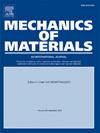Deep learning-assisted prediction of mean grain size of polycrystalline materials from ultrasonic wave response
IF 3.4
3区 材料科学
Q2 MATERIALS SCIENCE, MULTIDISCIPLINARY
引用次数: 0
Abstract
This study introduces a novel approach for the non-destructive automated prediction of mean grain size in polycrystalline materials, using ultrasonic testing combined with deep learning (DL) techniques. The proposed approach involves a 1D convolutional neural network (CNN) regression model designed to analyze the ultrasonic longitudinal wave responses of Inconel-600 specimens, with the goal of predicting their mean grain size. These wave responses are generated through Hanning tone burst load excitation. Initially, simulated longitudinal wave responses are obtained through numerical simulations for eight distinct mean grain sizes (ranging from to ). Neper software is utilized to generate simulated microstructures with varying mean grain sizes, followed by finite element (FE) simulation using the commercial tool ANSYS-APDL. Subsequently, experimental wave responses are captured for Inconel-600 specimens with three distinct mean grain sizes (, , and ), prepared through the annealing process. The variation in mean grain sizes among the specimens is observed through optical microscopic images. The experiments are conducted on an in-house experimental setup, with piezoelectric wafer transducers used to generate and sense the experimental wave responses. In addition to distinct mean grain sizes, wave responses are captured by varying locations, frequencies, and noise levels to create a comprehensive and diverse database. The complete database comprises 1155 experimental and simulated wave responses across 11 different mean grain sizes. 80% of the complete database is randomly chosen for training a 1D-CNN regression model, while the remaining 20% is used for testing. The model’s architecture is optimized for predictive accuracy, incorporating convolutional layers, activation functions, and a Huber loss metric. Training and validation demonstrate the model’s ability to learn complex patterns and generalize to unseen data effectively. Testing on unseen datasets yields promising results in predicting mean grain size values, with the model achieving an average relative error (ARE) of 6.24%.
基于超声波响应的多晶材料平均晶粒尺寸的深度学习预测
本研究介绍了一种利用超声检测结合深度学习(DL)技术对多晶材料的平均晶粒尺寸进行无损自动预测的新方法。该方法采用一维卷积神经网络(CNN)回归模型,分析Inconel-600试样的超声纵波响应,以预测其平均晶粒尺寸。这些波响应是通过汉宁音突发负载激励产生的。首先,通过数值模拟得到了8种不同平均晶粒尺寸(150 ~ 500μm)的纵波响应。利用Neper软件生成具有不同平均晶粒尺寸的模拟微观结构,然后使用商业工具ANSYS-APDL进行有限元(FE)模拟。随后,捕获了退火工艺制备的平均晶粒尺寸为20μm、67μm和107μm的Inconel-600试样的实验波响应。通过光学显微图像观察了试样平均晶粒尺寸的变化。实验是在室内实验装置上进行的,使用压电晶圆换能器来产生和感知实验波响应。除了不同的平均粒度外,还可以通过不同的位置、频率和噪声水平捕获波浪响应,从而创建一个全面而多样的数据库。完整的数据库包括11种不同平均粒度的1155个实验和模拟波响应。随机选择完整数据库的80%用于训练1D-CNN回归模型,剩下的20%用于测试。该模型的架构针对预测精度进行了优化,结合了卷积层、激活函数和Huber损失度量。训练和验证证明了模型学习复杂模式和有效推广到未见数据的能力。对未见过的数据集进行测试,在预测平均粒度值方面取得了令人鼓舞的结果,该模型的平均相对误差(ARE)为6.24%。
本文章由计算机程序翻译,如有差异,请以英文原文为准。
求助全文
约1分钟内获得全文
求助全文
来源期刊

Mechanics of Materials
工程技术-材料科学:综合
CiteScore
7.60
自引率
5.10%
发文量
243
审稿时长
46 days
期刊介绍:
Mechanics of Materials is a forum for original scientific research on the flow, fracture, and general constitutive behavior of geophysical, geotechnical and technological materials, with balanced coverage of advanced technological and natural materials, with balanced coverage of theoretical, experimental, and field investigations. Of special concern are macroscopic predictions based on microscopic models, identification of microscopic structures from limited overall macroscopic data, experimental and field results that lead to fundamental understanding of the behavior of materials, and coordinated experimental and analytical investigations that culminate in theories with predictive quality.
 求助内容:
求助内容: 应助结果提醒方式:
应助结果提醒方式:


